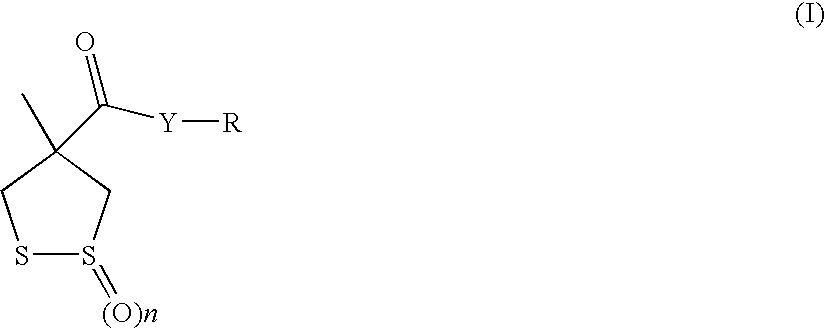Depigmenting keratin materials utilizing dithiolane compounds
a technology of dithiolane and keratin, which is applied in the field of cosmetic treatment regime, can solve the problems of difficult or even hazardous use, somewhat complicating the formulation of composition, etc., and achieve the effects of reducing observed side effects, strengthening action, and stable composition
- Summary
- Abstract
- Description
- Claims
- Application Information
AI Technical Summary
Benefits of technology
Problems solved by technology
Method used
Image
Examples
examples of synthesis
Example 1
Synthesis of 4-methyl-1,2-dithiolane-4-carboxylic Acid (Compound 1)
[0111]
[0112]8 g of dichloropivalic acid are placed in a 250 ml three-necked flask on which are mounted a condenser and a dropping funnel. The acid is dissolved in 80 ml of water, and 4.6 g of Na2CO3 are slowly added. A solution of 10.7 g of potassium thioacetate is added dropwise, and the reaction medium is brought to reflux. 14.9 g of Na2CO3 are added and the medium is again refluxed. After disappearance of the starting material, 7.3 ml of DMSO are added, followed by refluxing. The dithiolane is obtained after acidification by precipitating and drying the solid under vacuum. A pale yellow solid is obtained.
[0113]1H NMR (400 MHz, DMSO-d6): δ ppm 3.69 (d, 2H), 2.95 (d, 2H), 1.53 (s, 3H), ESI−: [(M, H)−]=163 m / z.
example 2
Synthesis of Octyl 4-methyl-1,2-dithiolane-4-carboxylate (Compound 9)
[0114]
[0115]1 g of acid (24) and then 0.8 ml of 1-chloro-N,N,2-trimethylpropenylamine (27) are placed in 20 ml of dichloromethane in a 100 ml three-necked flask using a syringe. The mixture is stirred for 1 hour, followed by dropwise addition via an additional funnel to a reaction medium at −5° C. containing 1.28 ml of triethylamine, 0.96 ml of octanol and 20 ml of dichloromethane. The mixture is stirred. The reaction medium is then washed with water (3×30 ml). The aqueous phase is extracted with 3×10 ml of EtOAc. The combined organic phases are washed with 30 ml of saturated aqueous NaCl solution and then dried over Na2SO4, filtered and then concentrated under vacuum (500 mbar, T=40° C.) on a rotavapor. The crude product obtained is a yellow oil (m=1.25 g). Purification is performed by flash chromatography on a column of silica (m SiO2=40 g, eluting with a 100 / 0 and then 98 / 2 heptane / EtOAc gradient).
[0116]After co...
example 3
Synthesis of S-[2-(acetylamino)ethyl]-4-methyl-1,2-dithiolane-4-carbothioate (Compound 13)
[0120]
[0121]Method identical to that of Example 2: the nucleophile used is N-acetylcysteamine (0.64 ml).
[0122]Purification is performed by flash chromatography on a column of silica (m SiO2=40 g; eluting with a linear gradient of 100 / 0 and then 98 / 2 DCM / MeOH).
[0123]After concentrating the fractions on a rotavapor (P=200 mbar, T=40° C.), 0.32 g of a mixture comprising the expected compound and N,N,2-trimethylpropionamide is obtained. After evaporating under vacuum, the expected final compound is obtained in the form of a thick yellow liquid. Yield=10%; Rf (expected)=0.3; eluent: 95 / 5 DCM / MeOH; 1H NMR (DMSO-d6): δ ppm 8.03 (t, NH), 3.57 (d, 2H), 3.18 (dt 2H), 3.10 (d, 2H), 2.96 (m, 2H), 1.79 (s, 3H), 1.43 (s, 3H); MS m / z (M+, 266; M+23, 288).
PUM
| Property | Measurement | Unit |
|---|---|---|
| temperatures | aaaaa | aaaaa |
| mean size | aaaaa | aaaaa |
| mean size | aaaaa | aaaaa |
Abstract
Description
Claims
Application Information
 Login to View More
Login to View More - R&D
- Intellectual Property
- Life Sciences
- Materials
- Tech Scout
- Unparalleled Data Quality
- Higher Quality Content
- 60% Fewer Hallucinations
Browse by: Latest US Patents, China's latest patents, Technical Efficacy Thesaurus, Application Domain, Technology Topic, Popular Technical Reports.
© 2025 PatSnap. All rights reserved.Legal|Privacy policy|Modern Slavery Act Transparency Statement|Sitemap|About US| Contact US: help@patsnap.com



